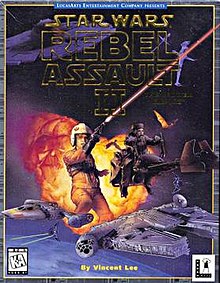Star Destroyers are capital ships in the fictional Star Wars universe. Star Destroyers were produced by Kuat Drive Yards, later Kuat-Entralla Engineering, and serve as "the signature vessel of the fleet" for the Galactic Republic, Galactic Empire, the First Order, and the Sith Eternal in numerous published works including film, television, novels, comics, and video games.
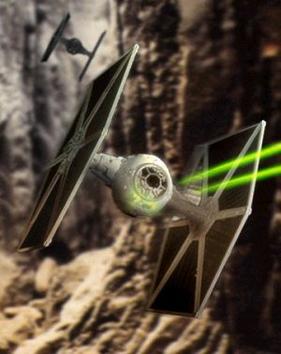
The TIE fighter or Twin Ion Engine fighter is a series of fictional starfighters featured in the Star Wars universe. TIE fighters are depicted as fast, agile, yet fragile starfighters produced by Sienar Fleet Systems for the Galactic Empire and by Sienar-Jaemus Fleet Systems for the First Order and the Sith Eternal. TIE fighters and other TIE craft appear in Star Wars films, television shows, and throughout the Star Wars expanded universe. Several TIE fighter replicas and toys, as well as a TIE flight simulator, have been produced and sold by many companies.
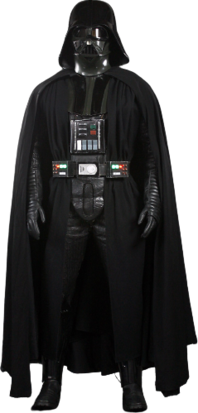
Darth Vader is a character in the Star Wars franchise. Vader is the secondary antagonist of the original trilogy and, as Anakin Skywalker, is the protagonist of the prequel trilogy. Star Wars creator George Lucas has collectively referred to the first six episodic films of the franchise as "the tragedy of Darth Vader". Darth Vader has become one of the most iconic villains in popular culture, and has been listed among the greatest characters. His masked face and helmet, in particular, is considered one of the most iconic character designs of all time.

The Galactic Empire, also known simply as the Empire, is a fictional autocracy featured in the Star Wars franchise. It was first introduced in the 1977 film Star Wars and appears in its two sequels: The Empire Strikes Back (1980) and Return of the Jedi (1983). It is the main antagonistic faction of the original trilogy. An oppressive, autocratic regime with a complicated bureaucracy, the Galactic Empire seeks to ensure singular rule and social control over every planet and civilization within the galaxy.

Grand Admiral Thrawn is a fictional character in the Star Wars franchise. He appeared as the eponymous character in the 1991–1993 Thrawn trilogy of novels by Timothy Zahn. An Imperial military leader and a member of the Chiss race, Thrawn leads remnants of the scattered Galactic Empire in the aftermath of its fall.
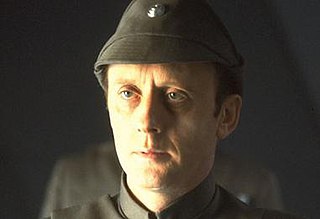
Admiral Firmus Piett is a fictional character from the Star Wars franchise, first introduced and portrayed by Kenneth Colley in the 1980 film The Empire Strikes Back. As a supporting villain in command of Darth Vader's flagship, Executor, Piett is generally considered to be the most prominent Imperial officer in the film. He subsequently appeared in the sequel Return of the Jedi, making him the only officer in the original trilogy to appear in more than one film and be portrayed by the same actor. Piett also appears in the canon Star Wars novel Lost Stars, and is featured in several more novels, comic books, and video games within the Star Wars Legends line.

Star Wars: Empire at War is a 2006 real-time strategy video game developed by Petroglyph Games and published by LucasArts for Microsoft Windows and Mac OS X. Set between Episode III and Episode IV, it focuses on the fledgling struggle between the Empire and the Rebels. It uses Petroglyph's game engine Alamo. In October 2006, an expansion titled Star Wars: Empire at War: Forces of Corruption was released. On May 31, 2014, online functionality, including network multiplayer and wireless chat, was discontinued after Glu Mobile's purchase of GameSpy and the subsequent shutdown of all game servers. As of September 1, 2017, the multiplayer has been re-enabled on the Steam version as well as workshop support being added.

Over one hundred video games based on the Star Wars franchise have been released, dating back to some of the earliest home consoles. Some are based directly on films while others rely heavily on the Star Wars Expanded Universe.
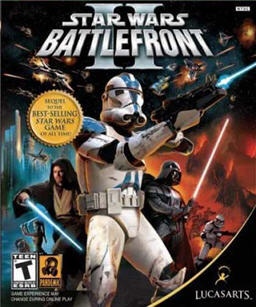
Star Wars: Battlefront II is a 2005 first and third-person shooter video game based on the Star Wars film franchise. Developed by Pandemic Studios and published by LucasArts, it is a sequel to 2004's Star Wars: Battlefront and the second installment in the Star Wars: Battlefront series. The game was released in PAL regions on October 28, 2005, on the PlayStation 2, PlayStation Portable (PSP), Microsoft Windows, and Xbox platforms, and in North America on November 1 of the same year. It was released on the PlayStation Store on October 20, 2009, for download on the PSP. The PSP version was developed by Savage Entertainment.

Star Wars: The Interactive Video Board Game: Assault on the Death Star is a board game and accompanying VHS video tape, released by Parker Brothers in 1996. It is notable for including new scenes shot twenty years after the first Star Wars film, featuring Darth Vader walking down the halls of the original Death Star set, in a performance reprised by David Prowse, James Earl Jones, and director of photography Gilbert Taylor. The game led to the canonization of four new characters in the Star Wars universe.
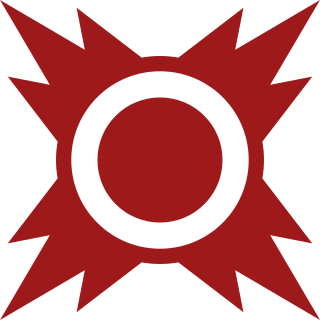
The Sith are the main antagonists of many works in the fictional universe of the Star Wars franchise. They are the antithesis and ancient enemies of the Jedi. The Sith Order is depicted as an ancient cult of warriors who draw strength from the dark side of the Force and use it to seize power by any means necessary, including terrorism and mass murder; their ultimate goals are to destroy the Jedi and rule the galaxy. The various antagonistic factions in the franchise, namely the Confederacy of Independent Systems, the First Galactic Empire, the Imperial Remnant and the First Order all originated, with the Sith. Sith, known individually as Sith Lords, are, by nature, ruthless. At any point a single individual assumes absolute authority amongst their kind and is granted the honorific Dark Lord of the Sith. Sith culture is based on perpetual treachery and betrayal. The fate of Sith Lords is, typically, to be murdered and replaced by their own apprentices. Sith teach their apprentices to revere the dark side of the Force, to give full reign to aggressive emotions such as rage and hatred, and to believe that others are expendable in the pursuit of power, it makes the Lords' demise inevitable.

Stormtroopers are soldiers in the fictional Star Wars franchise created by George Lucas. The term originates from the original SA of the Nazi party in Germany before Hitler's rise to power, Sturm Abteilung (Stormtroopers) abbreviated to SA. Introduced in the original Star Wars film, the stormtroopers are the shock troops/space marines of the autocratic Galactic Empire, under the leadership of Emperor Palpatine and his enforcers, most notably Darth Vader and Grand Moff Tarkin, during the original film trilogy (1977–1983) and Rebels (2014–18). The prequel trilogy (1999–2005) and The Clone Wars (2008–2020) explores their predecessors in the Galactic Republic's clone troopers, clones of the bounty hunter Jango Fett, used by Supreme Chancellor Palpatine to "win" the Clone Wars and later to take over the government and exterminate the Jedi. After this, in The Bad Batch (2021–present), stormtroopers are established as human recruits, trained by clone troopers gradually being phased out of active service; at the time of the original trilogy, only a few stormtroopers are clones, with the only known legion to still contain a significant number of clones being the 501st Legion, a.k.a. "Vader's Fist", with many stormtroopers remaining in service to Imperial remnants following the Empire's fall under Moff Gideon and Grand Admiral Thrawn in The Mandalorian (2019–present) and Ahsoka (2023). In the sequel trilogy (2015–2019), the First Order employs stormtroopers under the leadership of Supreme Leader Snoke and his enforcers, most notably Kylo Ren, General Hux, and Captain Phasma.

"Robot Chicken: Star Wars Episode II" is a 2008 episode of the television comedy series Robot Chicken, and the sequel to the Annie Award winning "Robot Chicken Star Wars", which aired as a one-off special during Cartoon Network's Adult Swim block on November 16, 2008. Like "Robot Chicken: Star Wars" it has been released on its own DVD, on July 21, 2009, and will not be part of a season box set. The DVD contains the original broadcast version, and the "Extended Version", which features an additional 15 minutes of footage cut from the broadcast version. It was nominated for a 2009 Primetime Emmy Award for Outstanding Animated Program.

Star Wars: The Force Unleashed II is an action-adventure video game developed and published by LucasArts. It is the second installment of The Force Unleashed multimedia project, and the sequel to Star Wars: The Force Unleashed (2008). The game was released in the United States on October 26, 2010, in Australia on October 27, and throughout Europe on October 29 for the PlayStation 3, Xbox 360, and Wii consoles, as well as Windows and the Nintendo DS and iOS portable devices.
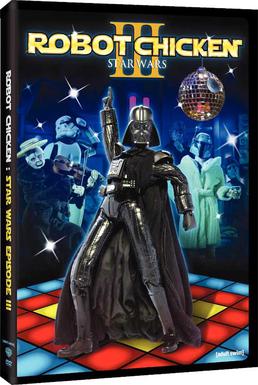
"Robot Chicken: Star Wars Episode III" is a 2010 episode special of the television comedy series Robot Chicken, and the third and final installment in the Annie Award-winning and Emmy-nominated Robot Chicken: Star Wars trilogy. It premiered on Cartoon Network's Adult Swim programming block on December 19, 2010. The special is 45 minutes long, as opposed to the usual 11-minute Robot Chicken runtime and the 21-minute runtime of the two previous Star Wars specials. It was the final Robot Chicken: Star Wars special.

The First Order is a fictional military movement and rump state in the Star Wars franchise, introduced in the 2015 film The Force Awakens. Following the fall of the Galactic Empire after the events of Return of the Jedi (1983), the First Order was formed to destroy the New Republic and rule the galaxy as an autocratic military dictatorship. It is the secondary antagonistic faction of the sequel trilogy. Aside from the films, the First Order appears in various related Star Wars media.
